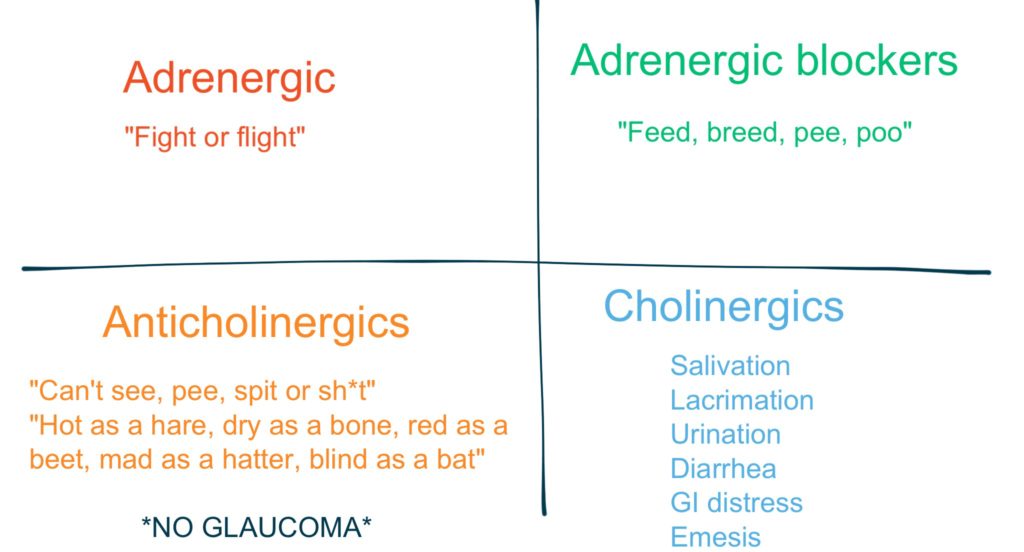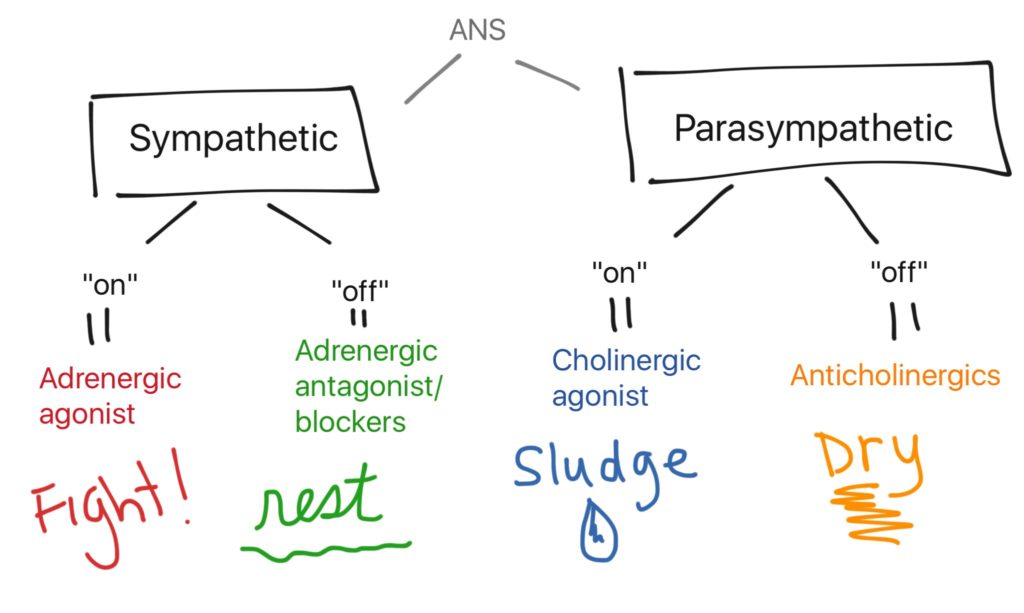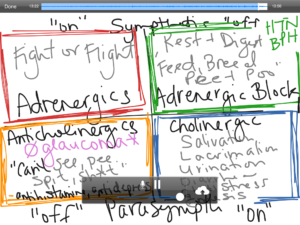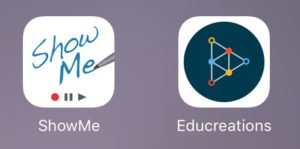I had a love/hate relationship with nursing pharmacology for my first year of nursing school. I loved the information but hated learning it. I didn’t figure out how to learn it effectively until we were 70% finished.
Since then I keep thinking, “there has to be a better way to learn nursing pharmacology.” I recently spent an hour with a new nursing student explaining how to remember adrenergic and cholinergic medications. So, while it was fresh in my mind, I thought I’d try recording an interactive whiteboard video with my strategy for remembering adrenergic, antiadrenergic, cholinergic and anticholinergic medications.
If the video doesn’t play, click here to view it on Edureations’ website. If you need a refresher on the anatomy and physiology of the autonomic nervous system, check out this Khan academy video.
If you watch the video, I’d love your feedback!
What’s in the video?
My go-to grid for exams
I like using this grid layout because:
- There are similarities between Adrenergics and Anticholinergics (I think of an angry, flushed, constipated person)
- There are similarities between Adrenergic Blockers and Cholinergics (increasing digestion and urination)

How to remember side effects
Adrenergic and Cholinergic medications mimic or block the autonomic nervous system (ANS), which is made up of the sympathetic and parasympathetic nervous systems.

Adrenergic agonists
Adrenergic agonists turn on the sympathetic nervous system = “fight or flight” side effects like:
- dilated eyes (to see better)
- bronchial dilation (to improve oxygenation)
- increased heart rate and blood pressure (to increase blood flow)
- increased glucose levels (to get more energy to the cells hat need it)
- decreased urination and gastrointestinal (GI) motility (it’s unlikely you’ll stop to use the restroom when you’re on the run!)
- decreased uterine contractions (do you really want to give birth when you’re in danger?!)
Basically, all the blood moves to the important parts of the body (heart, lungs) and away from digesting. Drugs include epinephrine, norepinephrine, and albuterol.
Adrenergic blockers/antagonists
Adrenergic blockers/antagonists (antagonists are the “against” the hero in literature) turn “off” the sympathetic nervous system which leads to “rest, digest, pee, poo.” This is the opposite of “fight or flight.”
- Increased uterine contraction (it’s a good time to have a baby!)
- decreased heart rate and glucose (you don’t need as much energy or blood when you’re relaxing)
- bronchial constriction (which is why some of these meds may be contraindicated for patients with respiratory problems),
- increased GI motility and urination
Cholinergic agonists
Cholinergic agonists mimic the parasympathetic nervous system by increasing Acetylcholine (ACh). This results in “SLUDGE:”
- Salivation,
- Lacrimation (tears/crying)
- Urination (Peeing)
- Diarrhea
- GI distress
- Emesis (vomiting)
Basically a person with excess ACh is going to have fluid coming from everywhere.
Anticholinergics
- Anticholinergics are the opposite of Cholinergics, they make a patient DRY by turning “off” the parasympathetic nervous system. Patients “can’t see, can’t pee, can’t spit, can’t sh*t.”
- Another rhyme that represents these side effect is “Hot as a hare, dry as a bone, red as a beet, mad as a hatter, blind as a bat”.
- Do NOT give anticholinergics to patients with glaucoma (The way I remember this is: it can be hard to see when you’re eyes are dry).
The tools I used
- iPad mini
- The stylus I used is too bulky. If I do this in the future I’m going to get a fine-tipped stylus like this one.
- Interactive Whiteboard App
- ShowMe (1st attempt)

- The end product was, well… boring and my digital writing was surprisingly sloppy (see the image!). The tool was okay.
- I wasn’t thrilled about the idea of having to either pay OR make my content shareable on their platform in order to publish it.
- I liked that I could select a variety of colors (Edureation limited me to 5 colors).
- Edureations (Final product)
- I liked the ability to edit the video as I made it and I can share my file without paying or
 making it part of the Edureations’ database.
making it part of the Edureations’ database. - It was also easier to move components around on the screen and there was the option to include grids and lines.
- I liked the ability to edit the video as I made it and I can share my file without paying or
- ShowMe (1st attempt)
This blog contains affiliate links.


44 responses to “Nursing Pharmacology: Adrenergics & Cholinergics”
Helpful!! Thank you!! P.s. I’m an INFJ too! 😉
It’s always great to meet another INFJ! I’m glad this was helpful.
Great Idea
I was able to finally understand
I’m looking forward to sharing with my classmates
Thank you
I’m a first semester nursing student
BSN#2019
I’m so glad this was helpful and that you’re going to share it with your classmates. Good luck on nursing school!
Thank you very much for this. I knew this stuff was connected but never was able to put it together so eloquently. I’m taking my NCLEX exam soon and this is super helpful. Thanks again. And good luck on your own test!
Good luck on the NCLEX!
great. used this to help tutor someone.
In Pharmacology now.. this was AWESOME. Very informative, thank you!!
So glad to hear that! Good luck!
Awesome work! Thank you!
i finally understand!! thank you!!!
Thank you so much! You would make an amazing Nursing Professor…
Aww… thanks, Christine. Best of luck as you study!
This was super helpful to me! I’m a very visual person and the charts and colors made it click for me, thank you 🙂
I’m so glad to hear that. I’m also very visual… I drew my way through nursing school using colors for specific things and making lots and lots of flow charts. Good luck!
This is great. I just have a question. You have rest under sympathetic , but I have always seen rest and digest with parasympathetic.
Hi Shari, great question. In the image where “rest” is under “sympathetic,” that represents drugs that turn OFF the sympathetic nervous system. The drugs that work AGAINST the sympathetic nervous system produce similar signs/symptoms as the parasympathetic nervous system. Does that help?
That’s what I assumed. Just wanted to make sure. Thanks
THANK YOU SOOOO MUCH!! My nursing program doesn’t have a separate pharmacology course so u learn pharm with the disease process as you go. I’ve been trying to understand this concept for a while and it is JUST NOW clicking. I’m so excited! thank you!!
I’m so glad to hear that!
Hilarious! LOL. What makes you laugh is also FACTUAL. Thank you for making the concept so easy to remember.
Thanks, Rachel!
Wow!! That was sooooo helpful!!!! Thank you so much for taking the time and creating this!!
Thanks, Kim! Glad it was helpful!
Thank you SO SO much for this!! Your video finally made it all click!
Amazing job, thank you so much. I think you actually did a better job of laying this out than my professor did.
I have a big pharmacology exam coming up and this has been extremely helpful. Thankyou so much for sharing!
I’m glad it was helpful! I hope your exam went well
I love the way you explain these. I understand. In pharmacology now. Thank you
I’m so glad to hear that!
Thank you so much!! This is the best review ever.
Thank you so much for this
I’m so glad it was helpful!
Thank you!!!
5 years later and this video just saved me for my pharm test!
I’m so glad to hear that! Good luck 🙂
Thank you so much for making this. You explained it in a much easier way than my Professor. I found you by googling it– since this is the subject that we are covering in my pharmacology class in my ASN program. I will bookmark your blog for more lectures.
I’m so glad it was helpful! Unfortunately I haven’t posted any other nursing pharmacology content. I wish you the best in nursing school!
THE most helpful and simple video! Thank you so much for sharing this! I hope you post more content with simple explanations like this <3 thank you!
I’m so glad it was helpful! I keep thinking about making more content but haven’t found the time het. Thanks for the encouragement
Krista, thank you for the work on this content. You offer a clear and concise explanation of this complex topic. I am so excited to share this with the current nursing cohort in the Pharmacology class. I am so proud that you are one of our grads! Thank you for doing such thoughtful work! I can see nursing education in your future!
Thanks for summery 🙏🙏 very helpful for me to revise with this chart.
This was so good! I understand it so much more now!! Thank you so much! –first semester nursing student (51 years old)
So glad it was helpful. Best wishes on nursing school!